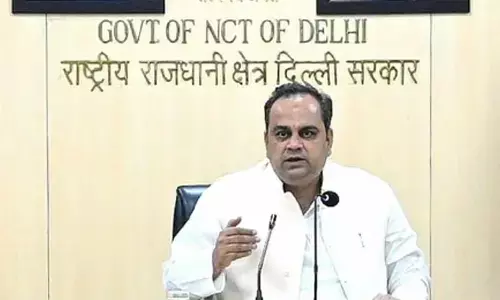Dance helps the mind and body

As a child Geetanjali Lal was fortunate to have support from her parents to pursue Kathak at a time when dance was a taboo for girls in India. In a candid interview the 68-year-old danseuse speaks about her tryst with classical dance.
As a child Geetanjali Lal was fortunate to have support from her parents to pursue Kathak at a time when dance was a taboo for girls in India. In a candid interview the 68-year-old danseuse speaks about her tryst with classical dance.
Excerpts
How was your childhood experience with classical dance?
I started to learn dance around the age of 6 years. Girls were generally not allowed to learn dance and at that time and I was the only disciple of Roshan Kumari. My mother used to say that I was dancing even before I started walking. When I told anyone about my classes, they would say in Gujarati ‘Oh Dance Kare Che’ (You dance!). In those days, it was so strict in the family that we were never allowed to go out of the house. So strict that even we could not walk across the street to eat the ‘Pani Puri’ also. My grandfather said ‘You are learning dance, but never take money and dance. I did not understand at that time what he actually meant. Later, I was trained by Gopi Krishna, whose role in ‘Jhanak Jhanak Payal Baaje’ of V Shantaram made Kathak the talk of whole India.
How did the training in other fields happen?
My father Rajnikant Desai was trained in music from Ustad Faiyaz Khan of Agra Gharana and taught at SNDT College, Mumbai. I learnt music from him. Since music was in the family, all musicians used to come home and it was nice to meet them and learn about life. My father was invited to head the Institute of Music and Fine Arts at Srinagar. It was a golden period around the year 1965 and Kashmir was truly a peaceful heaven on earth. I studied acting there and was very active in the theatre. After my graduation we came to Delhi, I learnt tabla at an institute, which taught many musical instruments.
What were your moments of glory in Kashmir?
I did my college in Kashmir, on the first day I wore a frock. And the principal was shocked and asked me to get back to home. I had to get a salwar kameez stitched at the earliest to get back to the college. Those were the days of women in ‘Burqa’. I acted in a film directed by Prabhat Mukherjee. I remember going for the shoot at Shalimar Gardens with Parikshit Sahni as the hero. It was based on the life of Kashmiri poet Ghulam Ahmed Mahjoor, titled ‘Shayar -E- Kashmir Mahjoor’.
Where did dance take you further in life?
After coming to Delhi, I started learning from Pandit Devi Lal of Jaipur Gharana, who was also the brother of Pandit Durga Lal. Later, I married Devi Lal and we also gave many performances in India and abroad. I started teaching at age of 36 in Kathak Kendra. I headed the Repertory of Kathak Kendra from 2009-2012. There are dancers and musicians on the salary basis, who constantly teach and also create ballets and works for professional performance. There have been moments when I could see many professional dance performances in Delhi including that of Yamini Krishnamurthy at her best.
How has been your experience of dance forms abroad?
The dance forms like ‘Flamenco’ are very close to Kathak in terms of rhythm. We understand the rhythm easily and can collaborate. In fact, it is said that the Spanish dancers must have migrated from Rajasthan long back. I have even collaborated with the music of African drummers, the music of Myanmar and songs from Iraq. It’s not difficult and adds a nice flavour to our work giving it a local touch.
What factors are important for the present day artistes to take up dance as a profession?
For an artiste, it’s very important to even understand the market dynamics. Once I had a show and when I was asked about my remuneration, I enquired about the budget that they had in mind. The organiser replied ‘You are a great artiste, but a bad business woman.’ Today, there is no objection for girls to learn dance. There are many platforms, festivals and the social media including YouTube, Facebook, and Twitter, which can make your work famous in seconds. I wish I was born in this era! But my glorious days are evergreen.
What are the important elements for any good artiste?
Today the ‘feel’ is missing. One has to live the ‘dance experience’. Even research scholars just ask people, visit museums and bring out a publication. This has a limitation. You cannot refine gold unless it is heated. The whole lifetime has to go into arts. There was a time when gurus used to put sand on the floor and ask disciples to practice dance on it. Dance brings discipline in body and life. One has to get up early, sleep on time and practice regularly. It helps mind and body to coordinate and concentrate. ‘Ekagrata’ and ‘Sadhana’ are the most important elements for any good artiste. It even sometimes takes you into a trance.
What’s happening in your life at the moment?
I am reading a book ‘My Name is Gauhar Jaan’. The first chapter talks about Hyderabad. And there are some points mentioned in the book, I have lived them. My son Abhimanyu Lal has taken Kathak at a very young age and guides the younger generation at Kathak Kendra.Vidha Lal, my daughter-in-law has been my student from the age of seven years. So it’s nice to see the legacy move forward right before my eyes.













